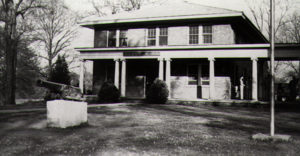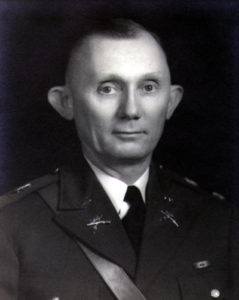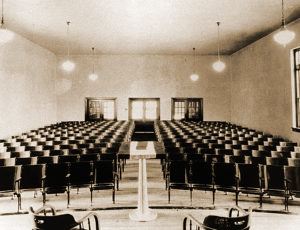The next big change in the Academy took place because of a disastrous fire which destroyed McComb Hall on January 20, 1924. The fire was discovered around 11pm in the basement, and soon spread to the entire building. Capt. Kennedy, who was Principal at the time, managed to wake the boys in the dormitory on the top floor of the building, and all of them escaped. The Port Gibson Reveille reported that “one student, Leon Terrell, took his small roommate, a little fellow of about twelve years, in his arms, and crawling through a third story window, carried his burden entirely around the building on the gutter, landing him safely from an adjoining roof.”
Capt. Kennedy then led the cadets in an attempt to save at least the north side of the building, but they did not succeed. After the fire, only the outer brick walls remained, so all the floors and windows and doors in the building had to be put back in after the fire.
 When McComb Hall was rebuilt, the top floor was omitted, either for economic or structural reasons. To replace the lost dormitory space, Redus Hall was completed in 1924. It was named for Dr. W.D. Redus, a medical doctor who lived in town and who had served as President of the Board of Trustees from 1902 until 1924.
When McComb Hall was rebuilt, the top floor was omitted, either for economic or structural reasons. To replace the lost dormitory space, Redus Hall was completed in 1924. It was named for Dr. W.D. Redus, a medical doctor who lived in town and who had served as President of the Board of Trustees from 1902 until 1924.
 Captain Kennedy, who was the Principal during the time of the fire, had first come the Academy in the Fall of 1916 to teach science. He was appointed Principal the next year, but because he was a reserve Army officer, he was called to active duty when the United States went to war with Germany in 1917. The First World War also increased interest in military education, and when Captain Kennedy returned to the Academy in the Fall of 1920, he became the Commandant. In the Fall of 1921, he became the President of the Academy, an office he would hold for over 20 years.
Captain Kennedy, who was the Principal during the time of the fire, had first come the Academy in the Fall of 1916 to teach science. He was appointed Principal the next year, but because he was a reserve Army officer, he was called to active duty when the United States went to war with Germany in 1917. The First World War also increased interest in military education, and when Captain Kennedy returned to the Academy in the Fall of 1920, he became the Commandant. In the Fall of 1921, he became the President of the Academy, an office he would hold for over 20 years.
 Kennedy was the first military man to head the Academy, and under his leadership the military program became strong and consistent. During the 1922-23 school year, the Academy received 75 rifles on loan from the War Department, along with yearly requisitions of ammunition so that every cadet could be trained in the use of modern weapons on the Academy’s rifle range.
Kennedy was the first military man to head the Academy, and under his leadership the military program became strong and consistent. During the 1922-23 school year, the Academy received 75 rifles on loan from the War Department, along with yearly requisitions of ammunition so that every cadet could be trained in the use of modern weapons on the Academy’s rifle range.
After World War I, many Presbyterians became concerned that military education was incompatible with the Christian gospel. Col. Kennedy disagreed strongly, and the Synod of Mississippi agreed with him, in a statement it issued in the early 1930’s, which read in part:
“The Presbyterian Church in the United States has approved and established not only theological seminaries for the training of her ministry, but schools and colleges for the training of the young for the varied duties of citizenship. National defense is a duty of citizenship made necessary by the depravity and greed of nations. The defense of persons and property in cities and states is also a duty of citizenship. It is reasonable that some preparation for these duties of defense be given.
 “The Synod of Mississippi’s aim is to have in all her schools a positive Christian influence. Military discipline in no way interferes with this. The punctual performance of the routine duties at school, habits of courteous and cheerful obedience to superiors who enforce the reasonable regulations of the schools, respect for order are the features of the system in force. To those who have experience in handling the young of the present generation it has been found that a system of regulations enforcing punctual attendance at meals, at classes, at study, periods, orderly behaviour at assemblies, the cooperation, subordination, and physical exercise of close-order drill is very, very desirable. With this discipline there is not and never has been any teaching of militarism. The teaching of the Bible is a part of the curriculum of all of the schools of the Synod of Mississippi. The aim of the Synod is to have in all her schools a definite and positive Christian influence. The best advocacy of peace the church can make is to propagate righteousness, inculcate respect for law and submission to authority.”
“The Synod of Mississippi’s aim is to have in all her schools a positive Christian influence. Military discipline in no way interferes with this. The punctual performance of the routine duties at school, habits of courteous and cheerful obedience to superiors who enforce the reasonable regulations of the schools, respect for order are the features of the system in force. To those who have experience in handling the young of the present generation it has been found that a system of regulations enforcing punctual attendance at meals, at classes, at study, periods, orderly behaviour at assemblies, the cooperation, subordination, and physical exercise of close-order drill is very, very desirable. With this discipline there is not and never has been any teaching of militarism. The teaching of the Bible is a part of the curriculum of all of the schools of the Synod of Mississippi. The aim of the Synod is to have in all her schools a definite and positive Christian influence. The best advocacy of peace the church can make is to propagate righteousness, inculcate respect for law and submission to authority.”
 One way that the Academy tried to implement Synod’s aim of a definite and positive Christian influence was with daily chapel services. In 1936, the Board of Trustees reported that “Chapel exercises were held each school day morning at the opening of school. These exercises consist of singing, reading from the Bible, and prayer. Themes dealing with life problems are outlined and discussed every day. The fundamentals of character and Christian manhood are constantly emphasized above other considerations of the school.”
One way that the Academy tried to implement Synod’s aim of a definite and positive Christian influence was with daily chapel services. In 1936, the Board of Trustees reported that “Chapel exercises were held each school day morning at the opening of school. These exercises consist of singing, reading from the Bible, and prayer. Themes dealing with life problems are outlined and discussed every day. The fundamentals of character and Christian manhood are constantly emphasized above other considerations of the school.”
Military training would prove essential to the United States with the outbreak of World War II. Major H.S. McCallum, the Commandant of Cadets who had served at the Academy for 17 years, was called to active duty in October of 1940. Capt. James Webb, who taught English and History, was called to active duty in June of 1941. Although he was a reserve officer, Col. Kennedy was not called to active duty, perhaps because his health was failing. He died in August of 1942.